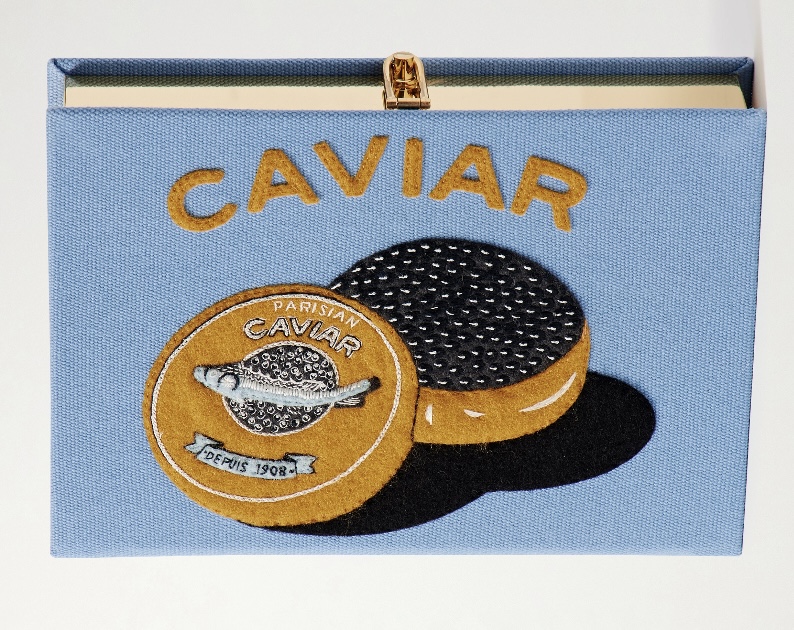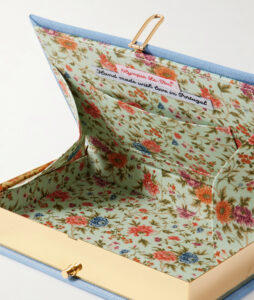In a world increasingly dominated by utilitarian design and mass-produced accessories, Olympia Le-Tan remains a fierce custodian of fashion’s most delightful contradiction: that whimsy and luxury can—and perhaps should—coexist. Her Caviar Embroidered Appliquéd Canvas Clutch, a small marvel of artistic expression, stands as a testament to this philosophy, merging narrative storytelling, haute craft, and a touch of irreverence into a singular object of desire.
To encounter an Olympia Le-Tan clutch for the first time is to be momentarily disarmed. These are not merely bags; they are talismans of another, more imaginative universe. With their intricate embroidery, hand-appliquéd motifs, and stiff book-like construction, they wink at the conventions of eveningwear, offering something playful yet painstakingly constructed. The Caviar clutch is no exception—perhaps even one of the brand’s most cunning embodiments of Le-Tan’s signature aesthetic.
A Gourmet Fantasy, Sewn by Hand
The Caviar Embroidered Appliquéd Canvas Clutch immediately seduces the eye with its richly detailed illustration: a tin of glossy black caviar rendered in painstaking stitchwork atop a cream-colored canvas backdrop. This is no digital print or facile pattern; each shimmering black bead that constitutes the caviar’s opulence is hand-sewn, with microscopic precision, onto the canvas ground. Tiny variations between the beads themselves only serve to heighten the clutch’s tactile dimension, inviting the hand as much as the gaze.
In an era when even luxury brands are outsourcing detail work to fast production lines, Olympia Le-Tan’s insistence on handmade embroidery remains a rare and radical commitment. Each clutch is created in limited quantities—often no more than sixteen to twenty pieces worldwide—ensuring not only the integrity of craftsmanship but also the rarity that luxury once promised.
But beyond its technical achievement, the Caviar clutch taps into something deeper: the humor and irony that underpin much of Le-Tan’s world. In choosing a caviar tin—long symbolic of extravagance and elite privilege—as the focal motif, she playfully toasts the absurdities of wealth, framing them within a coquettish, accessible object. It is a wink, not a sneer; a celebration, not a condemnation.
The Olympia Le-Tan Language: Where Fashion and Literature Collide
Since founding her brand in 2009, Olympia Le-Tan has cultivated a highly recognizable language rooted in the crossroads of literature, nostalgia, and French eccentricity. Many of her earliest designs famously reimagined the covers of classic novels—“Lolita,” “The Catcher in the Rye,” “1984”—as clutches, a move that announced her as one of the few designers willing to collapse the boundary between fashion and storytelling.
The Caviar clutch, while not drawn directly from a literary text, still feels deeply narrative. It is a snapshot of a life, a sensory memory, a fragment of glamour that conjures entire worlds: of candlelit restaurants along the Seine, of crystalline champagne flutes, of whispered conversations over mother-of-pearl spoons. In this sense, the clutch doesn’t just hold objects; it holds meaning, becoming a tiny archive of desire, pleasure, and playful subversion.
What makes Olympia Le-Tan’s pieces so enduring is their ability to feel both highly personal and broadly universal. They reference shared cultural signifiers, yet they invite the wearer to imbue them with their own memories, fantasies, and contexts. The Caviar clutch could, for one woman, summon memories of a first decadent meal in Paris; for another, it might simply embody the dream of abundance.
Construction and Details: A Testament to Artisanal Devotion
Examining the Caviar clutch up close reveals the layers of artisanal devotion baked into its construction. The exterior is a richly textured cotton canvas, onto which the embroidered and appliquéd elements are meticulously hand-placed. A discreet clasp opens the “book” to reveal a Liberty-print cotton interior—Le-Tan’s signature flourish—typically patterned with dainty florals or archival motifs that contrast playfully with the bold exterior.
The clutch’s structure is firm and precise, maintaining a boxy, rectangular silhouette that further enhances the illusion of a precious book or a miniature keepsake box. It is framed with silk piping and reinforced with a brass frame for durability. Measuring roughly 7 inches by 5 inches, it comfortably holds evening essentials: a phone, a lipstick, a few cards—little more, little less.
Each piece carries a handwritten edition number inside, linking it to its siblings across the world and underscoring its collectible status. In this sense, buying an Olympia Le-Tan clutch is less like purchasing a bag and more like acquiring a limited-edition artwork—one you can carry to dinner.
Cultural Resonance: Why Olympia Le-Tan Remains a Fashion Outsider Icon
While Olympia Le-Tan’s creations have long been adored by fashion insiders and celebrities—from Natalie Portman to Tilda Swinton—they have never achieved the sort of mass-market ubiquity that many luxury accessories now court. And that, perhaps, is their greatest strength.
In a marketplace increasingly flooded by logos and monograms, Le-Tan’s clutches stand as whispered luxuries, recognizable only to those who share a certain literary sensibility, a certain humor, a certain appreciation for the handmade. They are, in their very construction, a rejection of speed, trend-chasing, and vulgar ostentation.
The Caviar clutch, in particular, captures this outsider spirit beautifully. It is not an obvious choice; it requires the wearer to engage with its joke, its craftsmanship, its slight absurdity. To carry it is to signal an allegiance not just to luxury, but to the subversive pleasure of fashion that refuses to take itself too seriously.
Impression
Olympia Le-Tan’s Caviar Embroidered Appliquéd Canvas Clutch is a reminder that fashion, at its best, is a form of storytelling—and that the stories we choose to carry can be as rich, strange, and delicious as the ones we read, dream, and live.
It is a small object that asks big questions: about indulgence, about artifice, about the joys and ironies of luxury. And it answers them not with didacticism, but with laughter, embroidery, and a beadwork smile.
In an age of algorithmic sameness, Le-Tan’s work reminds us that there is still immense value in the human hand, the mischievous mind, and the well-told visual joke. The Caviar clutch is a triumph not just of design, but of spirit—a wearable celebration of life’s sweetest, saltiest contradictions.
No comments yet.








